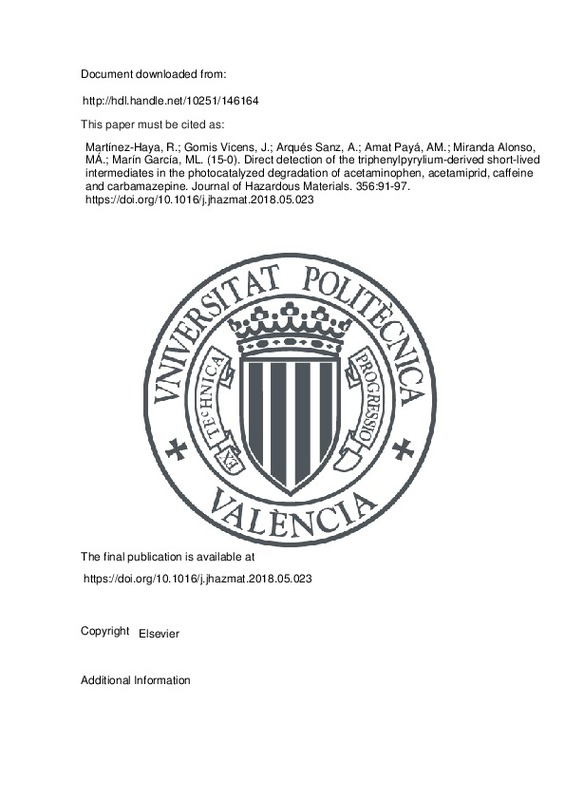JavaScript is disabled for your browser. Some features of this site may not work without it.
Buscar en RiuNet
Listar
Mi cuenta
Estadísticas
Ayuda RiuNet
Admin. UPV
Direct detection of the triphenylpyrylium-derived short-lived intermediates in the photocatalyzed degradation of acetaminophen, acetamiprid, caffeine and carbamazepine
Mostrar el registro sencillo del ítem
Ficheros en el ítem
| dc.contributor.author | Martínez-Haya, Rebeca
|
es_ES |
| dc.contributor.author | Gomis Vicens, Juan
|
es_ES |
| dc.contributor.author | Arqués Sanz, Antonio
|
es_ES |
| dc.contributor.author | Amat Payá, Ana María
|
es_ES |
| dc.contributor.author | Miranda Alonso, Miguel Ángel
|
es_ES |
| dc.contributor.author | Marín García, Mª Luisa
|
es_ES |
| dc.date.accessioned | 2020-06-12T03:33:20Z | |
| dc.date.available | 2020-06-12T03:33:20Z | |
| dc.date.issued | 2018-08-15 | es_ES |
| dc.identifier.issn | 0304-3894 | es_ES |
| dc.identifier.uri | http://hdl.handle.net/10251/146164 | |
| dc.description.abstract | [EN] Advanced oxidation processes are useful methodologies to accomplish abatement of contaminants; however, elucidation of the reaction mechanisms is hampered by the difficult detection of the short-lived primary key species involved in the photocatalytic processes. Nevertheless, herein the combined use of an organic photocatalyst such as triphenylpyrylium (TPP+) and photophysical techniques based on emission and absorption spectroscopy allowed monitoring the photocatalyst-derived short-lived intermediates. This methodology has been applied to the photocatalyzed degradation of different pollutants, such as acetaminophen, acetamiprid, caffeine and carbamazepine. First, photocatalytic degradation of a mixture of the pollutants showed that acetaminophen was the most easily photodegraded, followed by carbamazepine and caffeine, being the abatement of acetamiprid almost negligible. This process was accompanied by mineralization, as demonstrated by trapping of carbon dioxide using barium hydroxide. Then, emission spectroscopy measurements (steady-state and time-resolved fluorescence) allowed demonstrating quenching of the singlet excited state of TPP+. Laser flash photolysis experiments with absorption detection showed that oxidation of contaminants is accompanied by TPP+ reduction, with formation of a pyranyl radical (TPP center dot), that constituted a fingerprint of the redox nature of the occurring process. The relative amounts of TPP center dot detected was also correlated with the efficiency of the photodegradation process. | es_ES |
| dc.description.sponsorship | Financial support from Spanish Government (Grants SEV-2016-0683, CTQ2012-38754-C03-02 and CTQ2015-69832-C4-4-R) and Generalitat Valenciana (Prometeo Program) is gratefully acknowledged. R. Martinez-Haya thanks financial support from Spanish Government (Grant SEV-2012-0267). | es_ES |
| dc.language | Inglés | es_ES |
| dc.publisher | Elsevier | es_ES |
| dc.relation.ispartof | Journal of Hazardous Materials | es_ES |
| dc.rights | Reserva de todos los derechos | es_ES |
| dc.subject | Electron transfer | es_ES |
| dc.subject | Laser flash photolysis | es_ES |
| dc.subject | Singlet excited state | es_ES |
| dc.subject | Time-resolved fluorescence | es_ES |
| dc.subject | Triplet excited state | es_ES |
| dc.subject.classification | QUIMICA FISICA | es_ES |
| dc.subject.classification | QUIMICA ORGANICA | es_ES |
| dc.title | Direct detection of the triphenylpyrylium-derived short-lived intermediates in the photocatalyzed degradation of acetaminophen, acetamiprid, caffeine and carbamazepine | es_ES |
| dc.type | Artículo | es_ES |
| dc.identifier.doi | 10.1016/j.jhazmat.2018.05.023 | es_ES |
| dc.relation.projectID | info:eu-repo/grantAgreement/MINECO//SEV-2012-0267/ | es_ES |
| dc.relation.projectID | info:eu-repo/grantAgreement/MINECO//SEV-2016-0683/ | es_ES |
| dc.relation.projectID | info:eu-repo/grantAgreement/MINECO//CTQ2012-38754-C03-02/ES/DESARROLLO DE NUEVAS ESTRATEGIAS BASADAS EN LA INTEGRACION DE PROCESOS FOTOQUIMICOS SOLARES CON OTRAS TECNICAS AVANZADAS PARA EL TRATAMIENTO DE AGUAS RESIDUALES COMPLEJAS./ | es_ES |
| dc.relation.projectID | info:eu-repo/grantAgreement/MINECO//CTQ2012-38754-C03-03/ES/DESARROLLO DE NUEVAS ESTRATEGIAS BASADAS EN LA INTEGRACION DE PROCESOS FOTOQUIMICOS SOLARES CON OTRAS TECNICAS AVANZADAS PARA EL TRATAMIENTO DE AGUAS RESIDUALES COMPLEJAS/ | es_ES |
| dc.relation.projectID | info:eu-repo/grantAgreement/MINECO//CTQ2015-69832-C4-4-R/ES/TECNOLOGIAS EFICIENTES PARA LA ELIMINACION DE CONTAMINANTES DE PREOCUPACION EMERGENTE, CONTENIDOS EN DIRECTIVA 2013%2F39%2FCE O DE RIESGO SIGNIFICATIVO SEGUN DIRECTIVA 2008%2F105%2FCE/ | es_ES |
| dc.rights.accessRights | Abierto | es_ES |
| dc.contributor.affiliation | Universitat Politècnica de València. Departamento de Química - Departament de Química | es_ES |
| dc.contributor.affiliation | Universitat Politècnica de València. Departamento de Ingeniería Textil y Papelera - Departament d'Enginyeria Tèxtil i Paperera | es_ES |
| dc.description.bibliographicCitation | Martínez-Haya, R.; Gomis Vicens, J.; Arqués Sanz, A.; Amat Payá, AM.; Miranda Alonso, MÁ.; Marín García, ML. (2018). Direct detection of the triphenylpyrylium-derived short-lived intermediates in the photocatalyzed degradation of acetaminophen, acetamiprid, caffeine and carbamazepine. Journal of Hazardous Materials. 356:91-97. https://doi.org/10.1016/j.jhazmat.2018.05.023 | es_ES |
| dc.description.accrualMethod | S | es_ES |
| dc.relation.publisherversion | https://doi.org/10.1016/j.jhazmat.2018.05.023 | es_ES |
| dc.description.upvformatpinicio | 91 | es_ES |
| dc.description.upvformatpfin | 97 | es_ES |
| dc.type.version | info:eu-repo/semantics/publishedVersion | es_ES |
| dc.description.volume | 356 | es_ES |
| dc.identifier.pmid | 29857226 | es_ES |
| dc.relation.pasarela | S\347414 | es_ES |
| dc.contributor.funder | Generalitat Valenciana | es_ES |
| dc.contributor.funder | Ministerio de Economía y Competitividad | es_ES |







![[Cerrado]](/themes/UPV/images/candado.png)

